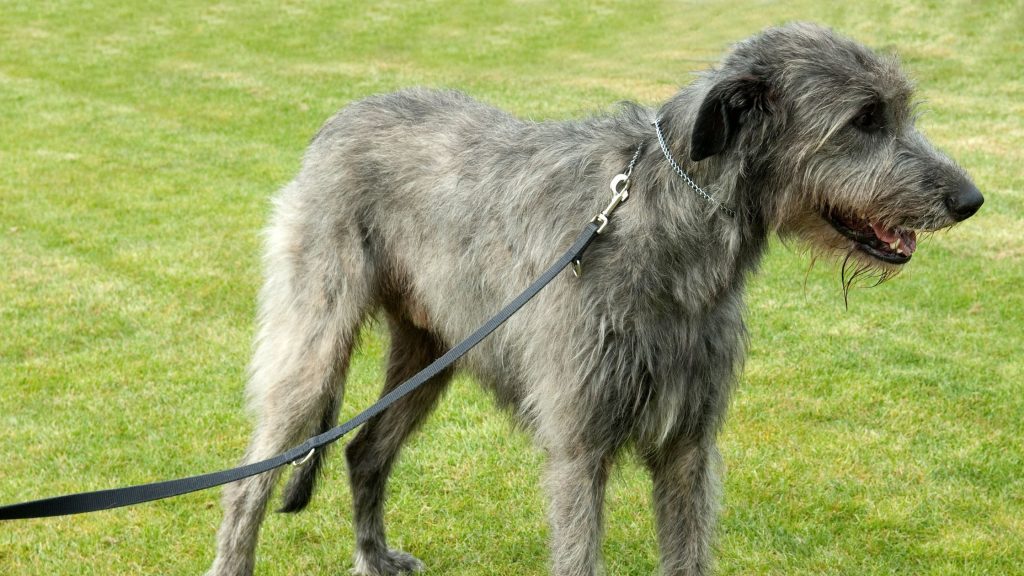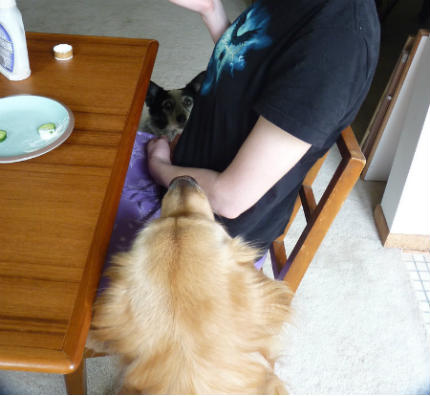The Scottish Deerhound is a dog unknown to the general public, since it is not common to see it outside of its native country, where Scottish deerhounds have become perfect companion dogs , which have not lost their hunting instinct.
- Weight : around 45 kilos
- Hair type : long and hard
- Character : calm and sociable
- Health : excellent
- Life expectancy : 8 to 10 years
origins
As with many dog breeds, the origin of the Scottish Greyhound is not at all clear, although from its appearance it seems that it comes from the same stock as the English Greyhound , which it closely resembles.
The belief is that it comes from the same bloodline as the English greyhound , but that the Scottish greyhound evolved to a larger size and longer coat due to the climate of the Scottish highlands, where it is very cold.
Its size would also be related to the use made of this dog, because unlike other greyhounds, it was not dedicated to hunting hares, but rather hunted deer. In fact, it was so prized that all Scottish clan chiefs had several.
As the centuries passed , it was on the verge of extinction , as the appearance and development of firearms changed the way of hunting deer. The disappearance of the clan system and the fencing of farms also contributed to this.
So much so, that around the year 1800 there were only a few specimens, although luckily there were fans who recovered this breed, making it reach our days.
Today its function is to be an excellent companion dog in its country of origin, since it is not well known outside of Scotland.
Main features
The first thing that stands out about the Scottish Deerhound is its size, as it is classified as a giant breed . Being a greyhound, the body is very thin and the legs are long, although it gives the impression of being strong.
Due to the length of its legs it looks like an ungainly dog, but we will not think the same if we see it running, when we are impressed to see how a dog that exceeds 70 cm and weighs 45 kilos moves.
It has an elongated head as well as its snout, powerful and with a scissor bite that helped it when hunting.
Its ears are raised folded when the dog is fully active, but are folded back if it remains at rest.
As for hair, different shades of gray are allowed. It can also be sand or tan red, yellow or fawn. The coat is rough, long, shaggy, forming a mustache and beard, which gives it a most peculiar expression.
Character
We can define the Scottish Deerhound as a calm dog , very sociable and affectionate with people and dogs, although given its strength and size, it is advisable to do socialization work with the puppy from a very early age.
They are good companions for children if they have been well socialized, but when they are adults they are very fond of peace and tranquility, which means that they must be provided with spaces where they can take refuge and rest.
They are very sociable with other dogs, so they are good candidates to live in a house where there are already other dogs, although this changes with smaller animals.
Although it is no longer used in hunting, its hunting instinct is very present. This means that it can try to hunt other small animals, including cats and even miniature dog breeds, so you have to be careful.
Since it is a very strong dog, it should be positively trained from a young age , as this will make it easier to handle when it is an adult.
It is not necessary to work in order to win an obedience contest, but you do need to learn basic commands such as sit, lie down, stop or come to call, which will make daily life with him easier.

Care
Among the main care that must be given is exercise . It is still a large sighthound, so it needs to run every day in large spaces.
This means that he should not live in an apartment, since his natural habitat is in a house in the countryside, although he is not a garden dog that we can separate from humans. He always asks for the affection of his loved ones and that is why he always has to be with his family.
Another care is related to the area in which you sleep. Here, we must give him a bed, otherwise he will suffer from calluses and sores on his paws, which occur if he sleeps in a hard place.
This is something that happens to most large dogs, as their weight creates pressure points when they lie down on the ground.
Hair needs constant attention
Although it seems that the hair is not going to require our attention, this is not the case. In fact, you will have to brush him every two days and daily when he sheds. Furthermore, due to his type of hair, he is a regular at dog grooming salons, where he will receive occasional trimming and stripping.
Both techniques consist of pulling out the hair , which is very common in wire-haired dogs such as the Scottish Deerhound.
We should space out baths as much as possible and when we go out into the countryside, it is always good to check the hair for parasites, scratches, pieces of branches, etc.
Feeding
As in all giant or large breeds, nutrition is essential for good body development. For this reason, and although you always have to take care of them, it is very important to be rigorous with them when they are puppies.
At this time, and very quickly, the Scottish Deerhound must produce an enormous amount of bone and muscle, so it will have to be provided with nutrients in order for it to do so.
You have to give them specific feed for giant breeds.
Within the dog food market we will find a huge variety, but in the case at hand we are interested in those specific to giant breed dogs.
These feeds are formulated according to the nutritional requirements of these breeds, so since the Scottish Deerhound is a puppy it will have to be fed with feed of this type.
The brands take into account what the size of the kibble should be, what elements dogs need in each part of their life, they can concentrate the nutrients so that the portions are smaller, etc.
Luckily, right now it is very easy to find a feed for each of the stages of the Scottish Greyhound's life , always choosing those that are of the highest quality due to their composition.
How do we choose quality feed?
Choosing a good feed is easier than we think. We can choose to buy one from a recognized brand, but the truth is that we just have to look at its list of ingredients.
Those of good quality will have meat suitable for human consumption. On the label, the ingredients are reflected so that the earlier they appear, the more product there is.
Thus, the first element should be meat and the feed will be better if it does not contain corn, barley or wheat, changing this source of carbohydrates for other more suitable ones such as potatoes.

Health
The health of the Scottish Deerhound is very strong. In fact, unlike what happens with other races, here we will hardly find specific diseases, with the exception of bone cancer.
stomach twist
One of the health problems most feared by owners of giant dog breeds is stomach torsion , which occurs when the stomach turns on itself due to a weakening of the tendons that hold it.
It is fatal if not treated in time, you have to act very quickly, and although not much is known, it seems that binge eating contributes to its occurrence.
Therefore, it is best to give the Scottish Deerhound food divided into several portions, never before going out into the field.
Hip dysplasia
Another disease that giant breeds suffer from is hip dysplasia , which occurs when the femur joint does not fit well in the hip.
It has several causes, but they are almost always genetic and that is why it is important to make sure that the parents of the puppy we bring home are free of the disease, something that today is very easy to certify.
It can also arise from environmental causes , such as excess weight or forcing the animal to exercise too much when it is growing, so you have to be careful.
Depending on the degree of the dysplasia, its symptoms can be alleviated with medications, but in the most serious cases the dog will have to undergo surgery.
bone cancer
Bone cancer is the only disease that affects the Scottish Deerhound more than normal, or in other words, to which it is prone due to its breed.
It is a very aggressive type of cancer that is seen more in large breed dogs than in small ones , and it usually kills the animal within a year in the best of cases, as long as radiotherapy is given.
Sometimes it can be stopped by amputating the affected limb, if the cancer is there, but the truth is that once it is detected, it is best for us to get used to the idea that our friend has little time left to live.
Other dog breeds that may interest you:












